Aga Khan Award for Architecture
The Aga Khan Award for Architecture (AKAA) is an architectural prize established by Aga Khan IV in 1977. It aims to identify and reward architectural concept that successfully address the needs and aspirations of Islamic societies in the fields of contemporary design, social housing, community development and improvement, restoration, reuse and area conservation, as well as landscape design and improvement of the environment.[1] It is presented in three-year cycles to multiple projects and has a monetary award, with prizes totalling US$ 1 million.[2] Uniquely among architectural awards, it recognizes projects, teams, and stakeholders in addition to buildings and people.[1]
The award is associated with the Aga Khan Trust for Culture (AKTC), an agency of the Aga Khan Development Network (AKDN).
Award process
The award is aimed at societies in which Muslims have a significant presence.[1] It is organised on the basis of a three-year cycle and is governed by a steering committee chaired by the Aga Khan IV.[3]
A new committee is constituted each cycle to establish the eligibility criteria for project, provide thematic direction with reference to current concerns, and to develop plans for the long-term future of the award. The Steering Committee is responsible for the selection of the Master Jury appointed for each award cycle, and for activities such as seminars and field visits, the award ceremony, publications and exhibitions.
Chairman's Award
The Chairman's Award is given in honour of accomplishments that fall outside the mandate of the Master Jury. It recognises the lifetime achievement. It has been presented four times: In 1980 to Egyptian architect and urban planner Hassan Fathy,[4] in 1986 to Iraqi architect and educator Rifat Chadirji,[5] in 2001 to Sri Lankan architect Geoffrey Bawa.,[6] and in 2010 to historian of Islamic art and architecture Oleg Grabar.[7]
Promotion
The Aga Khan Foundation funded the television series Architects on the Frontline which was about entries to the competition. The media watchdog Ofcom criticised BBC World News for breaking United Kingdom broadcasting rules with the series, which praised the competition; viewers were not informed that it was sponsored content.[8]
Award cycles
Prizes totalling up to US$ 1m, constituting the largest architectural award in the world,[1] are presented every three years to projects selected by the Master Jury.[3] Since 1977, documentation has been compiled on over 7500 building projects located throughout the world of which over 100 projects have received awards.[9] The current 12th Award Cycle runs from 2011-2013.
First (1978-1980)
The 1980 award ceremony took place at the Shalimar Gardens in Lahore, Pakistan. During this cycle, the Chairman's Award was given to Hassan Fathy in recognition of his lifelong commitment to architecture in the Muslim world. Prominent architect Muzharul Islam was a member of the Master Jury of the first Aga Khan Award for Architecture.

Award recipients:[10]
- Kampung Improvement Programme, Jakarta, Indonesia
- Pondok Pesantren Pabelan, Central Java, Indonesia
- Ertegün House, Bodrum, Turkey
- Turkish Historical Society, Ankara, Turkey
- Mughal Sheraton Hotel, Agra, India
- Conservation of Sidi Bou Saïd, Tunis, Tunisia
- Rüstem Pasa Caravanserai, Edirne, Turkey
- National Museum, Doha, Qatar
- Ali Qapu, Chehel Sutun, and Hasht Behesht, Isfahan, Iran
- Halawa House, Agamy, Egypt
- Medical Centre, Mopti, Mali
- Courtyard Houses, Agadir, Morocco
- Water Towers, Kuwait City, Kuwait
- Intercontinental Hotel and Conference Centre, Mecca, Saudi Arabia, by Rolf Gutbrod and Frei Otto
- Agricultural Training Centre, Nianing, Senegal
-
Conservation of Sidi Bou Saïd, Tunis
Second (1981-1983)
The 1983 award ceremony took place at the Topkapı Palace in Istanbul. Award recipients:[11]
- Great Mosque of Niono, Mali
- Šerefudin's White Mosque, Visoko, Bosnia and Herzegovina
- Ramses Wissa Wassef Arts Centre, Giza, Egypt
- Nail Çakirhan Residence, Akyaka Village, Muğla, Turkey
- Hafsia Quarter I, Tunis, Tunisia
- Tanjong Jara Beach Hotel and Rantau Abang Visitors' Centre, Kuala Terengganu, Malaysia
- Résidence Andalous, Sousse, Tunisia
- Hajj Terminal, King Abdulaziz International Airport, Jeddah, Saudi Arabia, by Fazlur Khan
- Tomb of Shah Rukn-i-'Alam, Multan, Pakistan
- Darb Qirmiz Quarter, Cairo, Egypt
- Azem Palace, Damascus, Syria
-

Nail Çakirhan Residence, Akyaka Village, Turkey
-
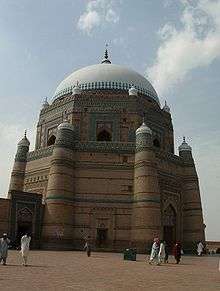
Mausoleum of Shah Rukn-i-Alam in Multan, Pakistan
-

Azem Palace, Damascus, Syria
-

Hajj Terminal
Third (1984-1986)
The 1986 award ceremony took place at El Badi Palace in Marrakesh, Morocco. The brief prepared by the Steering Committee for this award cycle focused on the preservation and continuation of cultural heritage, community building and social housing, and excellence in contemporary architectural expression.
Six winners were chosen from among 213 entries.[12] The conservation of Mostar Old Town and restoration of Al-Aqsa Mosque were examples of cultural heritage, the first theme, while the Yama Mosque and Bhong Mosque were noted for their innovation in translating traditional techniques and materials to meet contemporary requirements. The Social Security Complex and Dar Lamane Housing address the issues of community and social housing while remaining sensitive to local culture. The Chairman's Award for Lifetime Achievements was given to Iraqi architect Rifat Chadirji.

Award recipients:[13]
- Social Security Complex, Istanbul, Turkey
- Dar Lamane Housing, Casablanca, Morocco
- Conservation of Mostar Old Town, Bosnia and Herzegovina [14]
- Restoration of Al-Aqsa Mosque, Noble Sanctuary, Jerusalem
- Yaama Mosque, Yaama, Tahoua, Niger
- Bhong Mosque, Bhong, Rahim Yar Khan District, Pakistan
-
Restoration of Al-Aqsa Mosque, Jerusalem
Fourth (1987-1989)
The 1989 award ceremony took place at the Citadel of Salah Ed-Din in Cairo. The fourth cycle of the award considered 241 project nominations. Of these, 32 were short-listed for technical review[15] and the Master Jury selected 11 winners. Two themes were noted as areas of focus in this cycle: Revival of past vernacular traditions, and projects that reflect the efforts of individual patrons and of non-governmental organisations in improving society.
Projects such as the Great Omari Mosque and the Rehabilitation of Asilah seek to reconstruct and preserve heritage buildings for continued use, demonstrating the significance of these spaces within their communities. Meanwhile, the Grameen Bank Housing Programme and Sidi el-Aloui Primary School apply architectural solutions to address current socioeonomic issues.

Award recipients:[16]
- Great Omari Mosque (Sidon, Lebanon)
- Rehabilitation of Asilah (Asilah, Morocco)
- Grameen Bank Housing Programme (various locations in Bangladesh)
- Citra Niaga Urban Development (Samarinda, East Kalimantan, Indonesia)
- Gürel Family Summer Residence (Çanakkale, Turkey)
- Hayy Assafarat Landscaping and al-Kindi Plaza (Riyadh, Saudi Arabia)
- Sidi el-Aloui Primary School (Tunis, Tunisia
- Corniche Mosque (Jeddah, Saudi Arabia)
- Ministry of Foreign Affairs (Riyadh, Saudi Arabia)
- National Assembly Building (Sher-e-Bangla Nagar, Dhaka, Bangladesh), by Louis Kahn
- Institut du Monde Arabe (Paris, France), by Jean Nouvel and Architecture-Studio
-

Asilah Waterfront
-
.jpg)
National Assembly of Bangladesh, Dhaka
Fifth (1990-1992)
The 1992 award ceremony took place at the Registan Square in Samarkand, Uzbekistan. Uzbek government also released a postal stamp to commemorate the award ceremony & restoration of Registan Square in Partnership with Aga Khan Trust for Culture.
Award recipients:[17]
- Kairouan Conservation Programme (Kairouan, Tunisia)
- Palace Parks Programme (Istanbul, Turkey)
- Cultural Park for Children (Cairo, Egypt)
- East Wahdat Upgrading Programme (Amman, Jordan)
- Kampung Kali Code (Yogyakarta, Indonesia)
- Stone Building System (Daraa Governorate, Syria)
- Demir Holiday Village (Bodrum, Turkey)
- Pan African Institute for Development (Ouagadougou, Burkina Faso), by Association pour le Développement d'une Architecture et d'un Urbanisme Africains (A.D.A.U.A. - Association for the Development of African Architecture and Urban Planning)
- Entrepreneurship Development Institute of India (Ahmedabad, India), by Bimal Hasmukh Patel
-

Kairouan
Sixth (1993-1995)
The 1995 award ceremony took place at the Kraton Surakarta in Surakarta, Indonesia.
Award recipients:[18]
- Restoration of Bukhara Old City (Bukhara, Uzbekistan)
- Conservation of Old San'a' (San'a', Yemen)
- Hafsia Quarter II (Tunis, Tunisia)
- Khuda-ki-Basti Incremental Development Scheme (Hyderabad, Pakistan)
- Aranya Community Housing (Indore, India), by B.V. Doshi [19]
- Great Mosque and Redevelopment of the Old City Centre (Riyadh, Saudi Arabia)
- Menara Mesiniaga (Kuala Lumpur, Malaysia)
- Kaédi Regional Hospital (Kaedi, Mauritania), by A.D.A.U.A.
- Mosque of the Grand National Assembly (Ankara, Turkey)
- Alliance Franco-Sénégalaise (Kaolack, Senegal)
- Re-Forestation Programme of the Middle East Technical University (Ankara, Turkey)
- Landscaping Integration of the Soekarno-Hatta Airport (Cengkareng, Indonesia)
-

Bukhara Old City
-
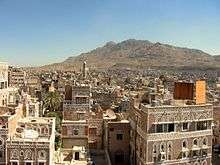
San'a'
-

Menara Mesiniaga
Seventh (1996-1998)
The 1998 award ceremony took place at the Alhambra in Granada, Spain. The Master Jury selected seven winning projects of the 424 presented. During this cycle, special emphasis was placed on projects that responded creatively to the emerging forces of globalization. Issues such as demographic pressure, environmental degradation, and the crisis of the nation-state, and the changes in lifestyle, cultural values, and relationships among social groups and between governments and people at large they prompted, were considered.
Of the winning projects, the rehabilitation of Hebron Old Town and Slum Networking of Indore City sought to reclaim community space in environments strained by social, physical and environmental degradation. The Lepers Hospital created a sustainable and dignified shelter for a marginalized segment of society. The remaining projects were recognized for their contribution in evolving an architectural vocabulary in response to contemporary social and environmental challenges.[20]
Award recipients:[21]
- Rehabilitation of Hebron Old Town
- Slum Networking of Indore, India
- Lepers Hospital, Chopda Taluka, India
- Salinger Residence, Bangi, Selangor, Malaysia
- Tuwaiq Palace, Riyadh, Saudi Arabia
- Alhamra Arts Council, Lahore, Pakistan, by Nayyar Ali Dada
- Vidhan Bhavan, Bhopal, India[22]
-
Hebron
Eighth (1999-2001)
The 2001 Award Presentation Ceremony took place at the Citadel of Aleppo in Syria. During this cycle, the Chairman's Award was given to Geoffrey Bawa to honour and celebrate his lifetime achievements in and contribution to the field of architecture.
Award recipients:[23]
- New Life for Old Structures (various locations, Iran)
- Aït Iktel (Abadou, Morocco)
- Kahere Eila Poultry Farming School (Koliagbe, Guinea)
- Nubian Museum (Aswan, Egypt)
- SOS Children's Village (Aqaba, Jordan)
- Olbia Social Centre of Akdeniz University (Antalya, Turkey), by Cengiz Bektas
- Bagh-e-Ferdowsi (Tehran, Iran)
- Datai Hotel (Langkawi, Malaysia)
-

Nubian Museum, Aswan
Ninth (2002-2004)
The 2004 award ceremony took place at the Humayun's Tomb in New Delhi, India. During the ninth cycle, 378 projects were nominated. Of these, 23 were site-reviewed, and the Master Jury selected seven award recipients.[24] Notable among the recipients are the Sandbag Shelter Prototypes, developed by Nader Khalili to enable victims of natural disasters and war to build their own shelter using earth-filled sandbags and barbed wire. The resulting structures - made up of arches, domes and vaulted spaces built using superadobe techniques - provide earthquake resistance, shelter from hurricanes and flood resistance, while being aesthetically pleasing.[25]

Other winning projects include a primary school in Gando, Burkina Faso, that combines high-caliber architectural design with local materials, techniques and community participation. The Bibliotheca Alexandria in Egypt and the Petronas Towers in Malaysia are examples of high-profile landmark buildings.
Award recipients:[26]
- Bibliotheca Alexandrina, Alexandria, Egypt, by Norwegian architectural office Snøhetta
- Primary School, Gando, Burkina Faso, by Diébédo Francis Kéré
- Sandbag Shelter Prototypes (various locations), developed by Nader Khalili
- Restoration of Al-Abbas Mosque (Asnaf, Yemen)
- Old City of Jerusalem Revitalisation Programme, Jerusalem
- B2 House, Ayvacik, Turkey, by Han Tümertekin
- Petronas Towers, Kuala Lumpur, Malaysia, by César Pelli
-

Bibliotheca Alexandrina
-
Primary School in Gando
-

Old city of Jerusalem
-
Petronas Towers within Kuala Lumpur cityscape
Tenth (2005-2007)
The 2007 Award Presentation Ceremony was held at the Petronas Towers in Kuala Lumpur, Malaysia. This cycle marked the 30th anniversary of the award. A total of 343 projects were presented for consideration, and 27 were reviewed on site by international experts.[27]
The award recipients were:[28]
- Samir Kassir Square, Beirut, Lebanon
- Rehabilitation of the City of Shibam, Yemen
- Central Market, Koudougou, Burkina Faso
- University of Technology Petronas, Bandar Seri Iskandar, Malaysia, by Foster + Partners
- Restoration of the Amiriya Madrasa, Rada, Yemen
- Moulmein Rise Residential Tower, Singapore, by WOHA Architects
- Royal Netherlands Embassy, Addis Ababa, Ethiopia, by Dick Van Gameren, Bjarne Mastenbroek
- Rehabilitation of the Walled City, Nicosia, Cyprus
- METI School in Rudrapur, Dinajpur, Bangladesh, by Anna Heringer
-
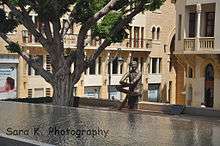
Samir Kassir Square in Beirut Central District
-
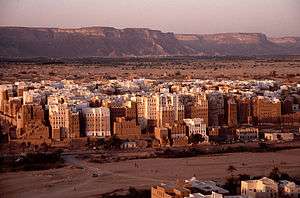
Shibam
-

University of Technology Petronas
-
University of Technology Petronas
-

Amiriya Madrasa
-
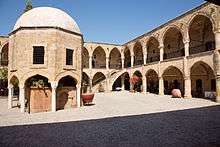
Büyük Han, Nicosia
Eleventh (2008-2010)
The 2010 Award Presentation Ceremony was held at the Museum of Islamic Art, Doha. A total of 401 projects were nominated of which 19 were shortlisted.[29]

The Chairman's Award went to Oleg Grabar.[7]
The award recipients were:[30]
- Wadi Hanifa Project, Riyadh, Saudi Arabia
- Revitalisation of nineteenth and early twentieth-century architectural heritage of Tunis, Tunisia
- Research Centre and Museum, Madinat Al-Zahra, Cordoba, Spain, by Nieto Sobejano Arquitectos[31]
- Ipekyol Textile Factory, Edirne, Turkey
- Bridge School, Xiashi, Fujian, China
-
Al Elb Dam, Wadi Hanifa
-

Cathedral of St. Vincent de Paul, Tunis, 1897
-
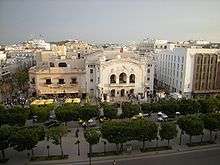
Municipal Theatre, Tunis, by Jean Emile Resplandy, 1902
-
.jpg)
Madinat Al-Zahra, Spain
-
.jpg)
Madinat Al-Zahra, Spain
Twelfth (2011-2013)
20 projects were shortlisted for the ceremony held in Lisbon in September 2013.[9][32]
The winning projects are:[33][34]
- Emergency[35] Salam Centre for Cardiac Surgery,[36] Khartoum, Sudan, by Italian practice Studio Tamassociati, completed in 2010
- Revitalisation of Birzeit Historic Centre, Birzeit, Palestine
- Hassan II Bridge, Rabat, Morocco
- Rehabilitation of Tabriz Bazaar, Tabriz, Iran
- Islamic Cemetery, Altach, Austria, by Austrian architect Bernardo Bader, inaugurated in 2012
-
Islamic Cemetery, Altach
-

Salam Centre for Cardiac Surgery, Khartoum
Thirteenth (2014-2016)
A total of 348 projects from 69 countries have been nominated. The winners are:[37]
- Bait Ur Rouf Mosque in Dhaka, Bangladesh by Marina Tabassum
- Friendship Centre in Gaibandha, Bangladesh by Kashef Chowdhury / URBANA
- Hutong Children’s Library and Art Centre in Beijing China, by ZAO, standardarchitecture, and Zhang Ke
- Superkilen in Copenhagen, Denmark by Bjarke Ingels Group, Topotek 1, and Superflex
- Tabiat Pedestrian Bridge in Tehran, Iran by Diba Tensile Architecture / Leila Araghian and Alireza Behzadi
- Issam Fares Institute in Beirut, Lebanon by Zaha Hadid Architects
-

Superkilen, Copenhagen
See also
References
- 1 2 3 4 "Aga Khan Award for Architecture." ArchitectureWeek 9 Jan. 2002.
- ↑ ^Canadian Architect, April 26, 2012.
- 1 2 Canadian Architect, 12 Jan. 2007.
- ↑ Lifetime Achievements of Hassan Fathy Archived February 8, 2012, at the Wayback Machine.
- ↑ Lifetime Achievements of Rifat Chadirji Archived February 8, 2012, at the Wayback Machine.
- ↑ Lifetime Achievements of Geoffrey Bawa Archived February 19, 2014, at the Wayback Machine.
- 1 2 Oleg Grabar acceptance speech
- ↑ "News channels breached sponsorship rules, Ofcom says". BBC News. 18 August 2015. Retrieved 18 August 2015.
- 1 2 Canadian Architect, May 11, 2013
- ↑ 1980 Cycle Awards Recipients
- ↑ 1983 Cycle Awards Recipients
- ↑ "The Changing Present, Loughran, G., Saudi Aramco World, Nov/Dec 1987: 28-37". Archived from the original on 29 December 2006. Retrieved 2006-12-06.
- ↑ 1986 Cycle Awards Recipients
- ↑ (AKTC) Archived February 8, 2012, at the Wayback Machine. (ArchNet) Archived February 8, 2006, at the Wayback Machine.
- ↑ "Better by Design, Loughran, G., Saudi Aramco World, Nov/Dec 1989: 28-33". Archived from the original on 29 December 2006. Retrieved 2006-12-06.
- ↑ 1989 Cycle Awards Recipients
- ↑ 1992 Cycle Awards Recipients
- ↑ 1995 Cycle Awards Recipients
- ↑
- ↑ Cynthia C. Davidson (ed.), ed. (1999). Legacies for the Future: Contemporary Architecture in Islamic Societies. New York: Thames and Hudson Ltd. ISBN 0-500-28087-8.
- ↑ 1998 Cycle Awards Recipients
- ↑ Vidhan Bhavan, (ArchNet)
- ↑ 2001 Cycle Awards Recipients
- ↑ "Aga Khan Award for Architecture 2004 - Architecture & Urbanism magazine, No. 78/79, Autumn/Winter 2005, Tehran". Archived from the original on 2 December 2006. Retrieved 2006-12-06.
- ↑ Aga Khan Award details.
- ↑ 2004 Cycle Awards Recipients Archived May 21, 2013, at the Wayback Machine.
- ↑ "Nine Projects Receive 2007 Aga Khan Award for Archicture" (Press release). Aga Khan Development Network (AKDN). 2007-09-04. Archived from the original on 10 September 2007. Retrieved 2007-09-06.
- ↑ 2007 Cycle Awards Recipients
- ↑ Jenna M. McKnight: Revealed: Winners of 2010 Aga Khan Award for Architecture, in the Architectural Record, November 24, 2010, retrieved 1 December 2010
- ↑ 2010 Cycle Awards Recipients
- ↑ Article on the project by the architects, Enrique Sobejano and Fuensanta Nieto
- ↑ World Architecture News, retrieved 6 May 2013
- ↑ Cathleen McGuigan: "Aga Khan Awards Go to Projects that Build Community", in The Architectural Record, 6 September 2013
- ↑ Aga Khan Award for Architecture 2013 Cycle Award Recipients
- ↑ http://www.emergency.it/
- ↑ http://www.salamcentre.emergency.it/
- ↑ Anna Fixsen: "BIG, Zaha Hadid Architects Among 2016 Aga Khan Award Recipients" in Architectural Record, 3 October 2016
Sources
- "Middle East Delights of Muslim architecture - BBC News, October 10, 1998". 1998-10-10. Retrieved 2006-12-06.
- "A Counterpoint of Cloth and Stone, Clark, A., Saudi Aramco World, Nov/Dec 1999: 2-7". Archived from the original on 29 December 2006. Retrieved 2006-12-06.
- "Elegant Solutions, Swan, S., Saudi Aramco World, Jul/Aug 1999: 16-27". Archived from the original on 29 December 2006. Retrieved 2006-12-06.
- "Shaking Up Architecture, Lawrence, L. A., Saudi Aramco World, Jan/Feb 2001: 6-19". Archived from the original on 29 December 2006. Retrieved 2006-12-06.
- Gerry Loughran, Better by design, 1989, Saudi Aramco World
Further reading
- Sardar, Zahid (2003-03-01). "Aga Khan Award for Architecture Building cultural bridges". San Francisco Chronicle. Hearst Communications Inc. Retrieved 2007-01-28.
- Sardar, Zahid (2005-03-09). "Culture's winning ways: The Aga Khan Award for Architecture's latest triumphs shows Islam's best". San Francisco Chronicle. Hearst Communications Inc. Retrieved 2007-01-28.
- "7 Projects Receive The 2004 Aga Khan Award for Architecture". ARCHI-TECH magazine. Stamats Business Media. November 2004. Archived from the original on February 9, 2016. Retrieved 2007-01-28.
External links
- Official website
- ArchNet Digital Library of Aga Khan Award for Architecture Winners
- Free IOS Application for offline consultation of the projects
.jpg)